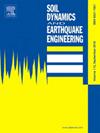Geotechnical subsoil modelling of a slope from the interpretation of ambient noise measurements and 2D site response analyses
IF 4.2
2区 工程技术
Q1 ENGINEERING, GEOLOGICAL
引用次数: 0
Abstract
Within the context of seismic risk assessment, the prediction of the dynamic response of natural slopes is strictly related to the accurate definition of the geotechnical subsoil model. This aspect is particularly challenging for those slopes characterised by the presence of buried morphologies, for which the vertical and lateral heterogeneities of the subsoil setting may predispose them to additional risks during seismic events. The paper proposes a methodological procedure aimed at identifying preliminary subsoil models of areas characterised by uneven topography and buried lithological bodies of uncertain morphology, through the comparison of parametric site response analyses and site-specific geophysical surveys. The procedure, tested with reference to the prototype case study of Costa del Canneto slope in Southern Italy, proves to be a useful tool to reduce the uncertainties associated with the presence of complex subsoil settings, including potential buried morphologies. Indeed, over several geotechnical models tested, the numerical analyses provide amplification profiles of the fundamental frequency reasonably comparable with data from ambient vibration measurements only for few of them. This allows to restrict the number of possible slope models and can be used to guide the design of additional in-situ geotechnical investigations needed to better characterise the stratigraphy of the area and constrain the geometry of the expected buried morphologies.
从环境噪音测量和二维场地反应分析的解释中建立斜坡的岩土地基模型
在地震风险评估的背景下,自然边坡动力响应的预测与岩土地基模型的准确定义密切相关。对于那些以埋藏形态为特征的斜坡来说,这方面尤其具有挑战性,因为地下土壤的垂直和横向非均质性可能使它们在地震事件中面临额外的风险。本文提出了一种方法程序,旨在通过参数化现场响应分析和现场特定地球物理调查的比较,确定地形不平坦和形态不确定的埋藏岩性体为特征的地区的初步底土模型。参考意大利南部Costa del Canneto斜坡的原型案例研究,该程序被证明是一种有用的工具,可以减少与复杂底土环境相关的不确定性,包括潜在的埋藏形态。事实上,在测试的几个岩土模型中,数值分析提供的基频放大曲线与环境振动测量数据相当,只有少数模型可以与环境振动测量数据相比较。这可以限制可能的斜坡模型的数量,并可用于指导设计额外的现场地质技术调查,以更好地描述该地区的地层特征,并限制预期埋藏形态的几何形状。
本文章由计算机程序翻译,如有差异,请以英文原文为准。
求助全文
约1分钟内获得全文
求助全文
来源期刊

Soil Dynamics and Earthquake Engineering
工程技术-地球科学综合
CiteScore
7.50
自引率
15.00%
发文量
446
审稿时长
8 months
期刊介绍:
The journal aims to encourage and enhance the role of mechanics and other disciplines as they relate to earthquake engineering by providing opportunities for the publication of the work of applied mathematicians, engineers and other applied scientists involved in solving problems closely related to the field of earthquake engineering and geotechnical earthquake engineering.
Emphasis is placed on new concepts and techniques, but case histories will also be published if they enhance the presentation and understanding of new technical concepts.
 求助内容:
求助内容: 应助结果提醒方式:
应助结果提醒方式:


